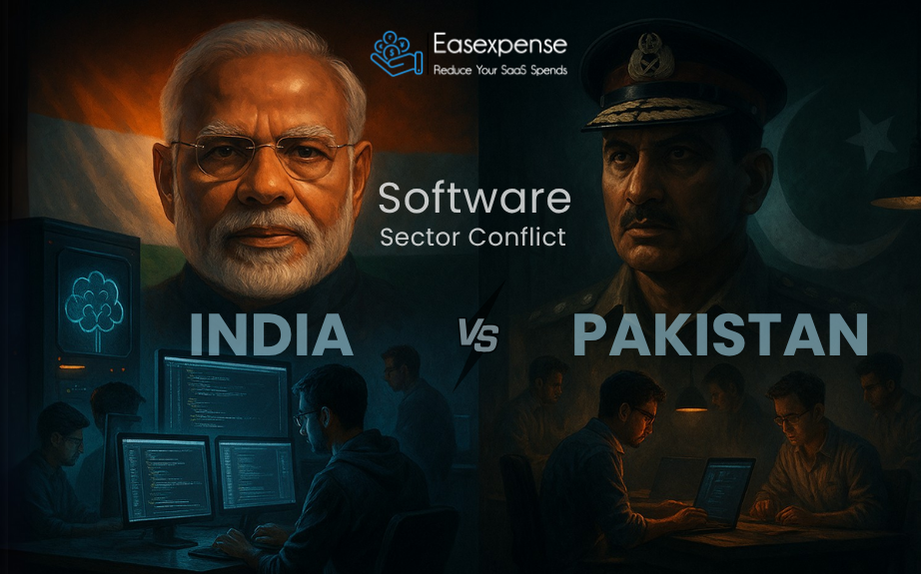Our Blogs
In the first quarter of 2025, the software sector across South Asia faced a major stress test due to escalating tensions between India and Pakistan. A combination of geopolitical instability, cyber warfare, infrastructure disruptions, and investor uncertainty led to a significant contraction in the region’s IT ecosystem.
Region-wide Decline in Software Exports
According to Dataquest (DQ) India, India’s software exports fell sharply from $39.2 billion in Q1 2024 to $32.1 billion in Q1 2025, reflecting an 18.1% decline. Pakistan witnessed a steeper drop of 20.8%, with software exports slipping from $2.4 billion to $1.9 billion in the same timeframe.
These figures not only highlight the fragility of the sector in times of conflict but also underline how quickly global demand can shift when operational stability is at risk.
“This isn’t just an economic dip—it’s a wake-up call for risk planning in the digital age,” says tech strategist Anjali Rawat.
Key Impacts of the Conflict on the Software Sector
1. Outsourcing Contracts Take a Major Hit
Foreign clients, particularly from the U.S. and Europe, have grown wary of placing new outsourcing orders in the region. An estimated 18% drop in outsourcing contracts was recorded, according to the Indian Software Exporters Association (ISEA).
“Clients expressed concerns regarding continuity in the face of cyberattacks or prolonged infrastructure outages,” shared Rajeev Menon, CTO at TriCode Systems.
Insurance premiums on projects originating from conflict-affected zones have also surged, prompting companies to rethink their sourcing strategies.
2. Massive Shift to Remote and Cloud-First Models
Conflict-related threats have physically displaced around 30,000 software engineers in North India, many of whom transitioned to remote-first roles, as per HR consulting firm People Bridge.
Meanwhile, software hubs in Lahore and Karachi faced severe outages lasting up to 72 hours, disrupting ongoing development work. As a response, many startups began accelerating their migration to cloud infrastructure, minimizing dependence on local data centers and on-premise systems.
3. Cybersecurity Becomes a Digital Battlefield
The surge in cyberattacks has been one of the most critical outcomes of the conflict. India’s Computer Emergency Response Team (CERT) reported a 42.5% increase in breaches, particularly targeting telecom, fintech, and defense tech platforms.
“Cyberwarfare has transformed into a covert battleground. Every organization is a potential target,” warned cybersecurity analyst Zara Husain.
Cross-border digital espionage, phishing campaigns, and infrastructure takedowns have become common, reinforcing the urgency for a more resilient security posture.
Venture Capital Dries Up
Investor confidence took a major blow, with VC funding in South Asian tech startups dropping by 33.3%, from $4.8 billion in Q1 2024 to $3.2 billion in Q1 2025. Global investors have adopted a wait-and-watch approach, seeking stability and lower geopolitical risk before committing further capital.
“Investors aren’t just betting on growth; they’re betting on predictability. Right now, that’s missing,” noted VC advisor Kapil Bhasin.
Strategic Implications for Tech Leaders
To navigate the post-conflict terrain, tech leaders must proactively rethink their operational strategies. Here’s how:
1. Diversify Development Centers
Avoid overdependence on any single geopolitical region. Explore emerging hubs in Southeast Asia (Vietnam, Philippines) and Eastern Europe to distribute your engineering bandwidth and reduce concentration risk.
2. Upgrade Disaster-Readiness
Revisit your business continuity plans (BCP). Ensure redundant internet lines, alternative data center backups, and ready-to-deploy remote teams. The 2025 conflict exposed vulnerabilities in power supply and last-mile internet that must now be addressed.
3. Rework Vendor Contracts & Insurance
Review force majeure clauses, cyber-insurance, and service-level agreements (SLAs). Contracts must be stress-tested against geopolitical risks, not just natural disasters.
4. Implement Zero-Trust Security Architecture
Cybersecurity can no longer be an afterthought. Enforce zero-trust models, conduct regular penetration testing, and invest in AI-driven threat detection systems. Security has now become your most critical infrastructure.
The Road Ahead
The Indo-Pak conflict of 2025 has pushed South Asia’s software industry into a phase of reflection and reformation. Beyond the numbers, it marks a turning point where software isn’t just about productivity—it’s about resilience, strategic foresight, and geographic diversification.
As digital conflict begins to mirror physical warzones, the tech sector must evolve from being just a service provider to becoming a fortified, globally agile, and proactive ecosystem.
Sources & Further Reading
In the first quarter of 2025, the software sector across South Asia faced a major stress test due to escalating
In a rapidly evolving global economy, technology procurement is facing new complexities. One of the most significant recent developments is
Expense approvals often turn into a game of email tag, dragging out reimbursements and frustrating everyone involved. Enter AI and
Expense management used to mean hoarding receipts and manually filling out reports. Today, with mobile expense management, businesses are streamlining
Gone are the days of shoeboxes full of receipts and endless spreadsheet entries. Fintech is redefining expense management, making it
Expense reports aren’t just paperwork; they’re the backbone of financial management. Yet, many businesses still rely on outdated tracking methods,
As a startup, having the right tools is crucial for scaling quickly and efficiently. SaaS (Software-as-a-Service) solutions offer the flexibility,
The dynamic world of SaaS is continually evolving, with new technologies and trends emerging at an astonishing pace. To remain








